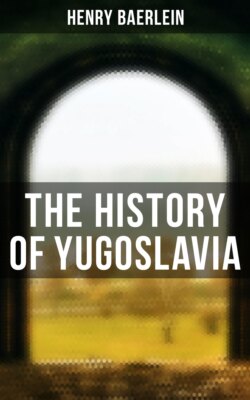Читать книгу The History of Yugoslavia - Henry Baerlein - Страница 7
На сайте Литреса книга снята с продажи.
INTRODUCTION THE TRAGEDY OF A FRONTIER
ОглавлениеTable of Contents
Kiepert, the famous geographer, was able, as the result of his diligent researches and explorations, to correct many errors in former ethnological maps; but in the map of the Balkan Peninsula, which he published in 1870, the country between Kustendil, Trn and Vranja is represented by a white space. And if the people who dwell in these wild, narrow valleys had been overlooked as thoroughly by subsequent Congresses and Frontier Commissions they would have been most grateful. They only asked—this well-built, stubborn race—that one should leave them to their own devices in their homes among the mountains where the lilac grows. They asked that one should leave them with their ancient superstitions, such as that of St. Petka, who inhabited a cavern high above the present road from Trn, while St. Therapon, so they say, lived by himself upon a neighbouring rock. Inside the cavern now the water drips continuously and is collected in large bowls; these are St. Petka's tears, which are particularly beneficial, say the natives, for afflicted eyes. But though this region is so poor that, towards the end of the Turkish régime and during the war of Bulgarian liberation and also in the winter of 1879–80, the people were compelled, through lack of flour, to use a sort of "white earth," bela zemja, yet this land was coveted, and now the maps no longer show an empty space but a variety of names and a frontier line. From the nomenclature we perceive that the region was visited of old by people who were not Slavs—such were those who gave to a mountain the name of Ruj, to a village the name of Erul, and to a river the name of Jerma, which has been explained as being derived from the Lydian Hermos, the river of St. Therapon's birthplace. The names of Latin colouring may either be memorials of the Romanized Thracians or else may refer to the mediæval Catholics, whether Saxon miners or travelling merchants. But there does not seem in the veins of the present population to be much trace of these other settlers or wayfarers; at any rate, the Slavs do not differ appreciably among themselves, and the drawing of a frontier line has been a peculiar hardship.
One of the greatest misfortunes of the nineteenth century was the creation of separate Serbian and Bulgarian kingdoms, wherein there was so small an ethnological difference between these two branches of the Yugoslavs; and in those districts where a frontier runs one sees especially how criminal it was to make this separation. Balkan philologists to-day will tell you—and even those who are in other respects the most rabid Serbs or Bulgars—that there is really no such thing as a Serbian and a Bulgarian language, but only groups of Yugoslav dialects. And yet it pleased the Great Powers to prevent the union of the two Balkan brothers. In that region with which we are dealing the Berlin Congress attempted to draw, with very inadequate maps, a frontier line along the watershed; and the Commissioners who were sent to mark out this line, observing that many of the indicated points did not coincide with the watershed, thought it would be preferable to trace the frontier along the saddle, between the tributaries of the Morava on one side and of the Struma and the river of Trn on the other. As the region was, however, not uninhabited the farmers were frequently cut off, as at Topli Dol and Preseka, from the meadows and the forests which they had regarded always as their own. Bismarck, speaking with indifference of "the fragments of nations that inhabit the Balkan Peninsula," could see in the national yearning of the Yugoslavs only a yearning for lawlessness and tumult. So he laboured at his plan of dominating Europe with the mighty structure of the German, Austro-Hungarian and Russian conservative empires; and if he built it over a stream of democracy, with results that are to-day apparent, who knows whether the statesmen of our day are not somewhere constructing a house which to our descendants will appear equally ridiculous? And anyhow, as we shall see, he was far from being the only offender at the Berlin Congress. If that particular strip of frontier had been drawn in the most unimpeachable fashion it would still have been iniquitous.
One may object that even if the people were divided by rough-and-ready methods, that was no reason why they should oppose each other, and indeed a number of frontier incidents which occurred between the time of the Congress and 1885 were not regarded, either by Serbs or by Bulgars, as being serious obstacles to a union. But Russia and Austria, revelling in the intrigues, continued to pull the two States now this way and now that, and all too frequently against each other. It can thus not be a matter of surprise if the rather inexperienced statesmen of those little countries fell into line with the two Great Powers and spent a good deal of their energies in assailing each other. So blind, alas! were these statesmen that all the tears of St. Petka would not have cured them, and now the two kindred people, so progressive in many ways, are—to speak of each people as a whole—further apart than when their shaggy forefathers came over the Carpathians. It has been the fate of the Yugoslavs—Slovenes, Croats, Serbs and Bulgars—to live for centuries beside each other and be kept always, by foreign masters, isolated from each other. At rare intervals, as we shall see in following their history, a person has arisen who has tried, with altruistic or with selfish motives, to make some sort of union of the Yugoslavs. And now we will go back to the time when Slavs first wandered westward to the Balkans.
